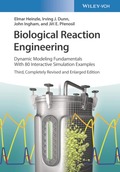Biological Reaction Engineering
Dynamic Modeling Fundamentals with 80 Interactive Simulation Examples

3. Edition April 2021
XXVI, Pages, Hardcover
300 Pictures
16 tables
Practical Approach Book
Wiley Online LibraryContentSample ChapterIndexSupplementary Material
Short Description
This book explains and provides the reader with information they need to analyze the behavior of complex biological reactors using a unique combination of mathematical equations and the powerful dynamic simulation language, Berkeley Madonna.
This book explains modeling and simulation of the dynamics of biological processes in a readily comprehensible manner, using the unique combination of simplified fundamental theory and direct hands-on computer simulation.
Biological systems modeled range from single enzymes to metabolic and multi-organism systems. The models for the kinetics are combined with the models of the reactors, which often include flow configuration and mass transfer aspects. In these many examples, bioreactor control and the optimization of their operation is also of interest. Simulation examples start from most simple ones reaching into recent research examples. The mathematics is kept to a minimum, and yet the numerous examples illustrate almost every aspect of biological engineering science, with each one described in detail, including the model equations.
The example programs are written in the modern, user-friendly simulation language Berkeley Madonna. Madonna solves models comprising many ordinary differential equations using very simple programming. Data may be included for curve fitting, and sensitivity or multiple runs may be performed. The results can be viewed simultaneously on multiple-graph windows or by using overlays. The examples can be varied to fit any real situation, and the suggested exercises provide practical guidance.
The extensive teaching and research experience of the authors is reflected in this well-balanced presentation, which is suitable for every biochemist, biologist, bioengineer and chemical engineer interested in modeling and simulation.
The applied software Berkeley Madonna for Mac and PC is available from the Berkeley Madonna website:
www.berkeleymadonna.com
By choosing Supplementary Material from this WILEY-VCH webpage, a Zip file can be downloaded. This contains all simulation example programs for the book, solutions of modeling exercises and a short description to using Berkeley Madonna.
Buyers of the book can buy the full Berkeley Madonna software at a reduced cost, as described in the appendix of the book.
Modeling Principles
Basic Bioreactor Concepts
Biological Kinetics
Bioreactor Modeling
Mass Transfer
Diffusion and Biological Reaction in Immobilized Biocatalyst Systems
Automatic Bioprocess Control Fundamental
Basic Cell and Bioreactor Models
Part II Dynamic Bioprocess Simulation Examples Using the BERKELEY MADONNA Simulation Language
Biological Reaction Process Modeling Examples
Simulation Examples of Biological Reaction Processes Using BERKELEY MADONNA
Appendix: Using the Berkeley Madonna Language and Accessing the Simulation Examples
C. Posten, Karlsruhe
CIT 3/04
"Besonders hervorzuheben ist der für ein Lehrbuch sehr erfreuliche durchgehend praktische Bezug. Das Buch ist meines Erachtens besonders gut für angehende Fachhochschulingenieure sowie für Studenten in Nebenfächern geeignet. Darüber hinaus kann es als erste Lektüre für denjenigen dienen, der sich in das Fachgebiet einarbeiten möchte."
Chemie Ingenieur Technik, B. Nienhaus, Frankfurt
Irving J. Dunn is retired from the ETH-Zurich, where he taught and did research in the area of biochemical engineering for over thirty years, within the Chemical Engineering Dept. His degrees are from the University of Washington and Princeton University. Dr. Dunn has published widely in his field, ranging from bioreactor design, process control, animal cell culture, and specialized wastewater treatment. His teaching and research has featured the use of modeling and simulation and has resulted in the publication of three textbooks: Biological Reaction Engineering, Dynamics of Environmental Bioprocesses and Chemical Engineering Dynamics. In 1981 he founded the renowned International Modeling and Simulation Courses in Braunwald, Switzerland.
John Ingham is now retired from Chemical Engineering at Bradford University U.K. The first of a long series of courses on the Modeling and Simulation of Dynamical Chemical Engineering Systems was begun there in 1974, sponsored by the Institution of Chemical Engineers and inspired by leave of absence at the ETH Zurich. Research areas include Liquid-Liquid Column Hydrodynamics, Extraction Process Dynamics and Biochemical Engineering; the latter, being developed, during a further leave of absence at the GBF, Braunschweig. He is especially proud of this and the two other VCH-Wiley Modeling and Simulation books.
Jirí E. Prenosil was born 1939 in Prague, Czechoslovakia. Educated in Prague with PhD in Chemical Engineering, he worked in the Czechoslovak Academy of Science and various universities abroad. 1971 he moved to Switzerland with appointment at the Swiss Federal Institute of Technology (ETH) in Zürich. 1984 he was a Visiting Professor at the University of London, Canada. His life interest is in Biochemical Engineering, design and modeling of bioreactors with immobilized biocatalysts. It has resulted in over 100 publications and co-authorship of two other books in this area. He is a co-founder of the renowned International Modeling and Simulation Courses in Braunwald, Switzerland since 1981. 1997 he was granted the Swiss Technology Transfer Award. In 2006, he retired from the ETH.


